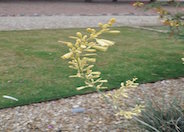
Common name:Hesperaloe Yellow
Botanical name:Hesperaloe parviflora 'Yellow'
Upright succulent grows quickly to 3' x 5'. The yellow flower stalks emerge in spring and remain on the plant until the end of summer. Dark green strappy leaves. Plants tolerate drought, full sun, reflected heat, poor soils, and frost.
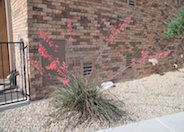
Common name:Bi-colored Hesperaloe
Botanical name:Hesperaloe parviflora 'Duet'
Spectacular accent for desert gardens anywhere. Plants tolerate drought, full sun, reflected heat, and poor soils. Forms rosettes of leaves 4' x 6'. The red and yellow flower stalks emerge in spring and remain on the plant until the end of summer. - Mountain States Nursery
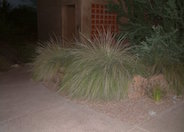
Common name:Bamboo Muhly
Botanical name:Muhlenbergia dumosa
Clumping grass grows at a moderate rate to 4' x 4'. Leaves are bright green and turn tan in fall. Flowering plumes appear fall, they start our green and dry to tan. Resembles short bamboo. Great in containers. Creates soft billowy effect in landscape. Accepts full sun or partial shade. Prune in spring when it begins growing & divide every 3-4 years. Native to Arizona and northwest Mexico.
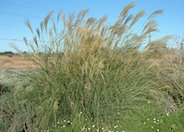
Common name:Upright Maiden Grass
Botanical name:Miscanthus sinensis 'Gracillimus'
The 'Gracillimus' is a taller variety, often growing to 6'-8' tall with delicate feathery plumes and very thin graceful leaves. It should receive sun to part shade, and average to little summer watering. Tall grasses are highly combustible.
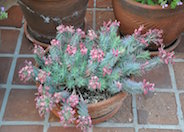
Common name:Donkey Tail Euphorbia
Botanical name:Euphorbia myrsinites
This hardy perennial grows 4-6" and has blue glaucous leaves that are stiff and round, set closely to the stem. Flattish clusters of chartreuse to yellow flowers bloom between late winter and early spring.
| Designer: Jennifer Barr | Barr Gardens 5 |
Photographer: GardenSoft |
Soils and Compost:
Practice grass-cycling by leaving short grass clippings on lawns after mowing, so that nutrients and organic matter are returned to the soil.
Water Saving Tip:
Different areas of your landscape have different water requirements.
Shrubs need much less water than lawns and drip systems should never be scheduled on the same program with lawns.
Establish separate watering schedules for those areas.
Integrated Pest Management:
Remove irrigation water and fertilizer from areas where you don't want weeds to grow.
